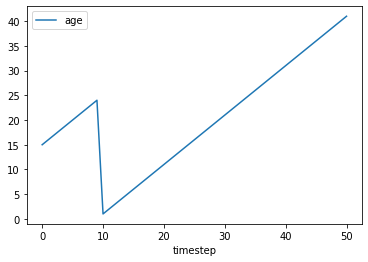Multi stand level modelling in libcbm¶
[1]:
from libcbm.model.cbm import cbm_variables
from libcbm.model.cbm import cbm_simulator
from libcbm.model.cbm.cbm_output import CBMOutput
from libcbm.model.cbm.stand_cbm_factory import StandCBMFactory
from libcbm.storage import dataframe
import pandas as pd
import numpy as np
define the CBM classifiers
[2]:
classifiers = {
"c1": ["c1_v1"],
"c2": ["c2_v1"],
}
define one or more merchantable volumes. The relationship between stands and volumes is defined by the classifier sets.
[3]:
merch_volumes = [
{
"classifier_set": ["c1_v1", "?"],
"merch_volumes": [
{
"species": "Spruce",
"age_volume_pairs": [
[0, 0],
[50, 100],
[100, 150],
[150, 200],
],
}
],
}
]
define the inventory to simulate
[4]:
n_steps = 50
n_stands = 1000
inventory = dataframe.from_pandas(
pd.DataFrame(
index=list(range(0, n_stands)),
columns=[
"c1",
"c2",
"admin_boundary",
"eco_boundary",
"age",
"area",
"delay",
"land_class",
"afforestation_pre_type",
"historic_disturbance_type",
"last_pass_disturbance_type",
],
data=[
[
"c1_v1",
"c2_v1",
"Ontario",
"Mixedwood Plains",
15,
1.0,
0,
"UNFCCC_FL_R_FL",
"None",
"Wildfire",
"Wildfire",
]
],
)
)
simulate using StandCBMFactory
note pre-dynamics func argument may be used to inspect and or modify the CBM state, variables and parameters in the simulation loop. In this example it is used to assign a disturbance type to all stands on timestep = 10
[5]:
def pre_dynamics(t, cbm_vars):
if t == 10:
parameters = cbm_vars.parameters.to_pandas()
# note type changes will not be allowed in libcbm, so care must be used when using pandas
parameters.loc[:, "disturbance_type"] = np.int32(1)
cbm_vars.parameters = dataframe.from_pandas(parameters)
else:
parameters = cbm_vars.parameters.to_pandas()
parameters.loc[:, "disturbance_type"] = np.int32(0)
cbm_vars.parameters = dataframe.from_pandas(parameters)
return cbm_vars
n_stands = inventory.n_rows
cbm_factory = StandCBMFactory(classifiers, merch_volumes)
csets, inv = cbm_factory.prepare_inventory(inventory)
with cbm_factory.initialize_cbm() as cbm:
cbm_output = CBMOutput(
classifier_map=cbm_factory.classifier_value_names,
disturbance_type_map=cbm_factory.disturbance_types,
)
cbm_simulator.simulate(
cbm,
n_steps=n_steps,
classifiers=csets,
inventory=inv,
pre_dynamics_func=pre_dynamics,
reporting_func=cbm_output.append_simulation_result,
)
plot the mean age to confirm the disturbance event had an effect on age
[6]:
cbm_output.state.to_pandas()[["timestep", "age"]].groupby(
"timestep"
).mean().plot()
[6]:
<AxesSubplot:xlabel='timestep'>
